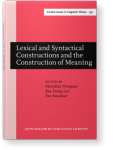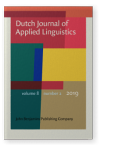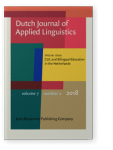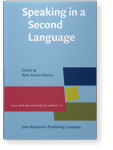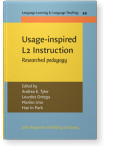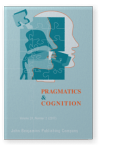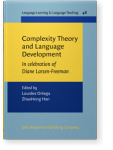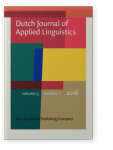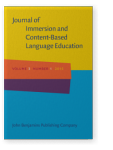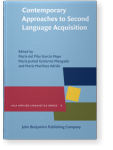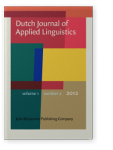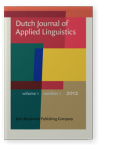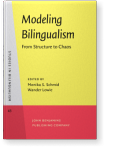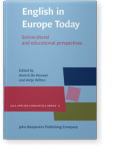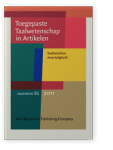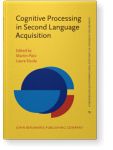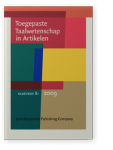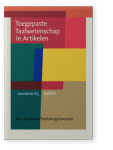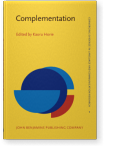Marjolijn H. Verspoor
List of John Benjamins publications for which Marjolijn H. Verspoor plays a role.
Book series
Yearbook
ISSN 1572-0268 | E-ISSN 1572-0276
Journal
ISSN 0019-0829 | E-ISSN 1783-1490
English Sentence Constructions
Marjolijn H. Verspoor, Tim Kassenberg, Merel Keijzer and Gregory J. Poarch
[Not in series, 240] 2022. 261 pp.
Subjects Electronic/Multimedia Products | English linguistics | Germanic linguistics | Syntax
Complex Dynamic Systems Theory and L2 Writing Development
Edited by Gary G. Fogal and Marjolijn H. Verspoor
[Language Learning & Language Teaching, 54] 2020. xvii, 304 pp.
Subjects Applied linguistics | Language acquisition | Language teaching | Writing and literacy
A Dynamic Approach to Second Language Development: Methods and techniques
Edited by Marjolijn H. Verspoor, Kees de Bot and Wander Lowie
[Language Learning & Language Teaching, 29] 2011. ix, 211 pp.
Subjects Applied linguistics | Language acquisition | Language teaching
Cognitive Exploration of Language and Linguistics: Second revised edition
Edited by René Dirven † and Marjolijn H. Verspoor
[Cognitive Linguistics in Practice, 1] 2004. xii, 277 pp.
Subjects Cognition and language
Explorations in Linguistic Relativity
Edited by Martin Pütz and Marjolijn H. Verspoor
[Current Issues in Linguistic Theory, 199] 2000. xvi, 369 pp.
Subjects Cognition and language | History of linguistics | Sociolinguistics and Dialectology
English Sentence Analysis: An introductory course
Marjolijn H. Verspoor and Kim Sauter
[Not in series, 100] 2000. 237 pp.
Subjects Electronic/Multimedia Products | English linguistics | Germanic linguistics | Syntax
Cognitive Exploration of Language and Linguistics
René Dirven † and Marjolijn H. Verspoor
[Cognitive Linguistics in Practice, 1 (1999)] 1999. xiv, 300 pp.
Subjects Cognition and language
Lexical and Syntactical Constructions and the Construction of Meaning: Proceedings of the bi-annual ICLA meeting in Albuquerque, July 1995
Edited by Marjolijn H. Verspoor, Kee Dong Lee and Eve Sweetser
[Current Issues in Linguistic Theory, 150] 1999. xii, 454 pp.
Subjects Cognition and language | Pragmatics | Semantics | Syntax
2020 Introduction Complex Dynamic Systems Theory and L2 Writing Development, Fogal, Gary G. and Marjolijn H. Verspoor (eds.), pp. ix–xviii | Chapter
2020 Chapter 2. Coordination of linguistic subsystems as a sign of automatization? Complex Dynamic Systems Theory and L2 Writing Development, Fogal, Gary G. and Marjolijn H. Verspoor (eds.), pp. 27–48 | Chapter
This study explored retrodictively differences in developmental patterns between a learner who makes some progress and one that does not. Their twelve successive writings were analyzed on holistically scored measures of complexity, accuracy, fluency, idiomaticity, and coherence (CAFIC) and on… read more
2019 Effectiveness of a dynamic usage based computer assisted language program Dutch Journal of Applied Linguistics 8:2, pp. 137–162 | Article
The current paper explores whether a Dynamic Usage Based (DUB) approach – which takes authentic meaningful language use with repetition and scaffolding for comprehension as its basis – can also be implemented in a CALL environment. The effectiveness of the DUB-CALL program was tested in a… read more
2018 Juggling ideals and constraints: The position of English teachers in CLIL contexts CLIL and Bilingual Education in the Netherlands, Mearns, Tessa and Rick de Graaff (eds.), pp. 177–202 | Article
In bilingual streams in the Netherlands, school subjects are taught in an additional language so that pupils learn both subject content and the target language by using language meaningfully. Teachers of English in bilingual streams (TEBs) are often expected to collaborate with subject teacher… read more
2018 Chapter 5. The acquisition of L2 speaking: A dynamic perspective Speaking in a Second Language, Alonso, Rosa Alonso (ed.), pp. 105–125 | Chapter
The complex dynamic systems theory approach to second language development has great explanatory power in accounting for the development of speaking as an emergent process. CDST approaches focus on the process of development, rather than on the products of learning, and often include the… read more
2018 Chapter 3. Foreign language instruction from a dynamic usage-based (DUB) perspective Usage-inspired L2 Instruction: Researched pedagogy, Tyler, Andrea E., Lourdes Ortega, Mariko Uno and Hae In Park (eds.), pp. 55–73 | Chapter
In this chapter we combine ideas of usage based linguistics and dynamic systems theory to argue that language is a dynamic usage based system and L2 learning is a dynamic process. Two teaching approaches based on Dynamic Usage-based (DUB) principles with mainly implicit attention to form – a movie… read more
2017 From conceptualization to constructions in Finnish as an L2: A case study Pragmatics & Cognition 24:2, pp. 212–262 | Article
This study traces the individual learning trajectories of an adult beginner L2 Finnish learner in expressing the extralinguistic concept of evaluation from a dynamic usage-based perspective. Our results provide support for the view of learner language as a dynamic system in which patterns wax… read more
2017 Chapter 7. Complex Dynamic Systems Theory and L2 pedagogy: Lessons to be learned Complexity Theory and Language Development: In celebration of Diane Larsen-Freeman, Ortega, Lourdes and ZhaoHong Han (eds.), pp. 143–162 | Chapter
If we assume that language is a complex adaptive system, the learner is a complex adaptive system, and the teaching and learning is a dynamic process – in which all relevant cognitive, physical, and social systems interact over time – then we must attend to all these systems and their relevant… read more
2016 An exploratory study into the dynamics of Chinese L2 writing development Dutch Journal of Applied Linguistics 5:1, pp. 65–96 | Article
The present study is inspired by the often heard Chinese university level students’ complaint that they do not improve in English proficiency during their university courses. With a pre-post design, the study explores the potential gains in language development in free response data (writing… read more
2015 The effects of English bilingual education in the Netherlands Journal of Immersion and Content-Based Language Education 3:1, pp. 4–27 | Article
This paper reports on the effectiveness of bilingual education in the Netherlands. After a brief history of the rise of bilingual education in the Netherlands, the study traces the development of English proficiency of two cohorts at Dutch high schools during one year: a group of Year 1 students… read more
2013 Chapter 10. Dynamic Systems Theory as a comprehensive theory of second language development Contemporary Approaches to Second Language Acquisition, García Mayo, María del Pilar, María Juncal Gutiérrez Mangado and María Martínez-Adrián (eds.), pp. 199–220 | Chapter
In this contribution it is argued that Dynamic Systems Theory (DST) can be seen as a comprehensive theory that can unify and make relevant a number of different ‘middle level’ theories on Second Language Acquisition (SLA) which in our view are theories that attend to different levels of granularity… read more
2012 A dynamic perspective on language processing and development Dutch Journal of Applied Linguistics 1:2, pp. 188–218 | Article
If language processing and development is viewed as a dynamic process in which all subsystems interact over time, then some basic assumptions behind more traditional approaches to language analysis are problematic: new methods of analysis and modeling are needed to supplement and partly replace… read more
2012 Measuring effectiveness in Focus on Form versus Focus on Meaning Dutch Journal of Applied Linguistics 1:2, pp. 263–276 | Article
So far empirical studies have shown that explicit Focus-on-Form (FonF) methods are more effective than implicit Focus-on-Meaning (FonM) methods (Norris & Ortega, 2000). However, many studies fail to address the notion of ‘effectiveness’ and the tests used usually favor the explicitly taught FonF… read more
2012 Conventionalized ways of saying things (CWOSTs) and L2 development Dutch Journal of Applied Linguistics 1:1, pp. 125–142 | Article
Taking a usage-based approach, this paper aims to define conventionalized ways of saying things (CWOSTs) as multi-word units so that they can be included in researching L2 development. We build on Langacker’s (2008) “normal ways of saying things”, here understood as conventionalized… read more
2011 Introduction A Dynamic Approach to Second Language Development: Methods and techniques, Verspoor, Marjolijn H., Kees de Bot and Wander Lowie (eds.), pp. 1–4 | Introduction
2011 Variability and DST A Dynamic Approach to Second Language Development: Methods and techniques, Verspoor, Marjolijn H., Kees de Bot and Wander Lowie (eds.), pp. 55–84 | Article
2011 The dynamics of multilingualism: Levelt’s speaking model revisited Modeling Bilingualism: From Structure to Chaos, Schmid, Monika S. and Wander Lowie (eds.), pp. 267–288 | Article
Levelt’s blueprint of speech production and perception (Levelt 1989; Levelt, Roelofs, & Meyer 1999) has been widely accepted and is well established. One of the crucial characteristics of the model is its modularity, which is required to account for the speed with which we speak (about two to three… read more
2011 Coding and extracting data A Dynamic Approach to Second Language Development: Methods and techniques, Verspoor, Marjolijn H., Kees de Bot and Wander Lowie (eds.), pp. 39–54 | Article
2011 Dynamic Systems Theory and a usage-based approach to Second Language Development A Dynamic Approach to Second Language Development: Methods and techniques, Verspoor, Marjolijn H., Kees de Bot and Wander Lowie (eds.), pp. 25–38 | Article
2011 Visualizing interactions between variables A Dynamic Approach to Second Language Development: Methods and techniques, Verspoor, Marjolijn H., Kees de Bot and Wander Lowie (eds.), pp. 85–98 | Article
2011 English as a foreign language: The role of out-of-school language input English in Europe Today: Sociocultural and educational perspectives, De Houwer, Annick and Antje Wilton (eds.), pp. 147–166 | Article
This chapter investigates to what extent the process of second language acquisition is influenced by amount and type of input. After a brief description of the place of English in the lives of secondary school students in the Netherlands, the article reports on a semi-longitudinal study comparing… read more
2011 The Role of Input and Scholastic Aptitude in Second Language Development Taalbeleid en meertaligheid, pp. 47–60 | Article
This semi-longitudinal/cross-sectional study explores the role of two possible variables in the L2 development of Dutch high school students: scholastic aptitude (operationalized as CITO score) and the amount of input, both in school (two hours a week versus 15 hours a week) and out of school.… read more
2011 How to sections A Dynamic Approach to Second Language Development: Methods and techniques, Verspoor, Marjolijn H., Kees de Bot and Wander Lowie (eds.), pp. 129–200 | Article
2010 8. Conceptual representations in the multilingual mind: A study of advanced Dutch students of English Cognitive Processing in Second Language Acquisition: Inside the learner's mind, Pütz, Martin and Laura Sicola (eds.), pp. 135–148 | Article
2009 De Ontwikkeling van Schrijfvaardigheid in het Fins als Vreemde Taal: Een Dynamisch Perspectief Toegepaste Taalwetenschap in Artikelen 81, pp. 121–132 | Article
Within Dynamic Systems Theory (DST), it is assumed that differences in the degree of variability can provide insight into the process of L2 development. This longitudinal case study investigates intra-individual variability in Finnish learner language, focusing on the development of accuracy and… read more
2001 Het Leren van Polyseme Woorden Vanuit de Kernbetekenis Toegepaste Taalwetenschap in Artikelen 65, pp. 9–21 | Article
Studies in vocabulary acquisition have shown that guessing words from context may have a positive effect on eventual retention, but is not necessarily the most effective or efficient method in instructional settings. However, when cognitive linguistic insights into the conceptual links between… read more
2000 Preface Explorations in Linguistic Relativity, Pütz, Martin and Marjolijn H. Verspoor (eds.), pp. vii–viii | Preface
2000 Introduction Explorations in Linguistic Relativity, Pütz, Martin and Marjolijn H. Verspoor (eds.), pp. ix–xvi | Miscellaneous
2000 Iconicity in English complement constructions: Conceptual distance and cognitive processing levels Complementation: Cognitive and functional perspectives, Horie, Kaoru (ed.), pp. 199–225 | Chapter
1999 Predicate Adjuncts and Subjectification Lexical and Syntactical Constructions and the Construction of Meaning: Proceedings of the bi-annual ICLA meeting in Albuquerque, July 1995, Verspoor, Marjolijn H., Kee Dong Lee and Eve Sweetser (eds.), pp. 433–450 | Article

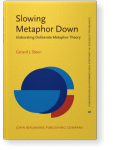
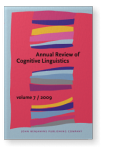
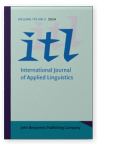
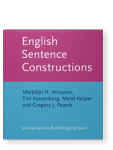
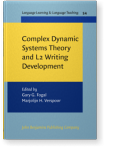
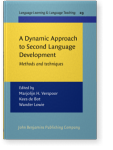
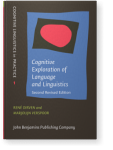
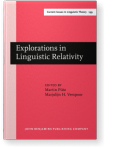
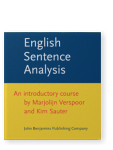
.hb.png)
